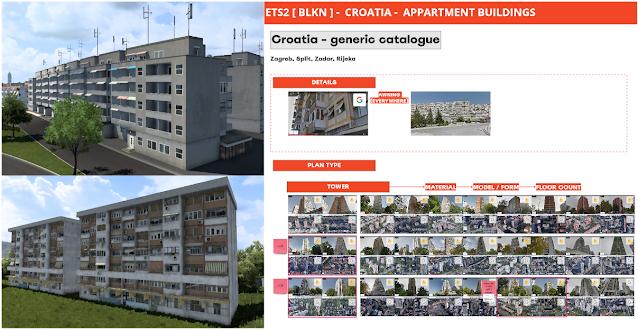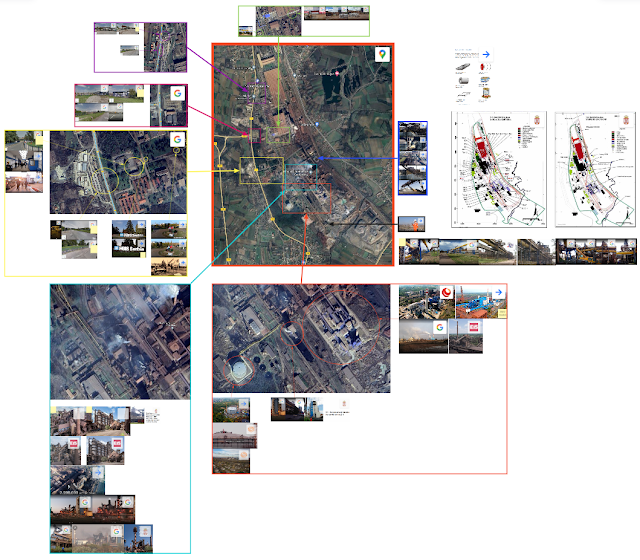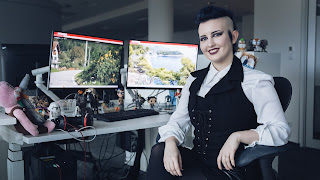In our previous "Under the Hood" blog posts, we have occasionally touched on how the research department contributes to the development process in areas such as map design, character, and asset creation. Now it’s time to discuss in greater detail what role the department plays in the overall process of designing a map expansion, what specific functions it carries out, and which challenges did we have to overcome when researching the West Balkans DLC.
Initially, our researchers were meant to help map designers and 3D artists by looking up references, but at some point, the research team transformed into an independent department that took on a variety of functions, including game design. Today there are 14 researchers in total, plus 2 interns. Half of the team is involved with Euro Truck Simulator 2 and the other with American Truck Simulator. Some of them are not assigned to a particular project and work on shared tasks across both games.
One of our researchers, Veru, gave us an example of such difficulties: “When working on references for a new set of advertising billboards for the West Balkans DLC, we had to pay attention not only to common themes and features that are present on such billboards but also to the different languages used on them. Eventually, this required additional cooperation with the 3D Designers as well as the extensive use of dictionaries.”
Once it is decided what the next map expansion is going to be, the researchers are among the first to look at the new state. “We focus not just on a particular region, but on the entire country or geographical area in general,” says Veru. “Our goal is to formulate how the country’s different parts are related to each other. This is especially important in the case of such projects as the West Balkans DLC that encompass more than one country. The diversity of the visual references requires us to pay special attention to the details revealing how something can be similar, yet distinct. It may be extremely difficult to discover such features. For example, we’ve noticed that there has been a rise in construction activity in the Balkan region. How should we represent it? Should we focus on construction sites, or instead imagine how things will look like once the buildings are finished?”
Reality is almost always more flexible and complex than any attempt to conceptualize it. Part of the research department’s responsibility is to find ways in which to recreate the world considering that it’s constantly changing, yet some aspects of it remain the same.
Additionally, the work of the research team is about more than simply looking at things. Rather, the researchers try to discover patterns and repetitive motifs in reality. Once map designers and visual artists start working on a new project they usually require structures that they can use to “build” our game world.
Agreeing on what particular models we need to design is not an easy task. One needs to distill the most representative elements of an area and come to a conclusion about what assets are going to express the country’s identity to the fullest. In such discussions, the researchers are usually those who have the experience-based knowledge to suggest what models should be chosen amongst the variety of visual data. Researcher Dirk describes this process in the following way: “When we think, let's say, of how to choose a street lamp we want to model for a country such as Montenegro, we have to take into consideration all the different types of lamps used not only in that country but also in other parts of the Balkans. Ideally, the lamp we choose as our model should express the idea of what a lamp is in that particular region.”
Even though selecting a typical model from a larger group of references may seem like a rational process, it is often a more complex task. Here is how researcher Eliška sums it up: “Being able to say what kind of house, or what architectural style is the most typical in a geographical area is a task where you have to trust your feelings. You always have to be on the lookout not to miss anything important. Minor details often matter the most. Sometimes the only way to get an answer is to use your intuition. Before you can do that, you’ve got to study a whole lot of references and tons of visual material.”
These principles apply to both Euro Truck Simulator 2 and American Truck Simulator. As Eliška explains: “Regions such as the Balkans are known for their diversity and variability in terms of houses, landscape, and nature. On the contrary, in the US the architectural identity of a state can reveal itself in such peculiarities as the shape of the house’s roof, or the material from which they’re built. What kind of doors are installed in residential houses in Texas and Oklahoma? What is the most typical color of a barn in a given state and how is it connected to its agricultural traditions? Being able to answer these questions means succeeding at creating a unique and immersive experience for our players.”
Some aspects of the researchers’ work are closely related to understanding how the world functions in general. This can be illustrated by how the department is involved in the process of designing a depot. In our games, a depot is a place where players pick up and deliver cargo. Its creation requires the collective effort of researchers, 3D artists, map designers, and programmers. A depot has to make sense logically and visually, it has to have the right dimensions to fit inside the map, and, most importantly, it has to make sense economically as part of larger chains of industries that already exist in the game.
Researcher Jiří, who is responsible for most industry-related matters inside Euro Truck Simulator 2 and American Truck Simulator, describes his involvement in the process in the following manner: “Working on a depot, we start by considering things at large. What industries are the most characteristic of a country? Answering that question can be especially thrilling in the case of areas such as the Balkan region where geographical diversity allows for industrial variability. For example, a country with prominent water areas receives a port, whereas another can receive a heavy industrial factory. Once we are done with the macro analysis we move on to the micro level and discuss cargo, surroundings, and the visual aspects.”
It may be captivating to invent ways in which different facilities can make sense inside a larger whole. Even more thrilling may be analyzing the minuscule details of how a particular factory works. We need to understand correctly what is going on technically and logically in every corner of an industrial facility we design, and the researchers are often asked the toughest questions. What’s the role of that building in the industrial process? Where do the trucks park? How does this or that thing works? Only when we have a complete picture of an industrial process can we be sure that our players will receive the most accurate representation of reality and therefore the most thrilling gaming experience.
Sometimes finding the required information can be extremely difficult. Since our truck simulation games often depict specific locations that are not very well-known, there can be a lack of references. “We’ve got our little tricks on how to cope with such problematic situations, but from time to time even our proven research methods fall short,” says researcher David, ”In such cases, we have to play the detective and solve the mystery ourselves.” Imagine having to find the location of a gas station or a toll gate when you only have a few low-quality pictures of it. You have to guess where it is situated judging by the surroundings depicted in the photographs. Spot a rock, a terrain, an elevation, or a random building, compare it with a map, and you may be lucky to find the location.
But sometimes the researchers’ work is not about finding the references themselves. Rather, it is about what the eye cannot see: the feeling of a country or a geographical area. It may be something about the country’s culture or the way people live there. As another researcher, Mary, explains: “Often these are the things that we have to imagine based on the references. For example, with vegetation research, it’s one thing to simply look at a tree in the photograph and another to imagine what it feels like to stand near it. In some parts of the Balkan region, we've noticed a lot of pine trees, so we discussed how great it must be to walk around them and feel their majestic smell. Things like that cannot be seen, but they subconsciously affect our perception of that region."
Generally speaking, being able to describe the feeling of a country or a geographical area is about understanding what it’s like to be there. Since the researchers study each state or area from various points of view, they can then suggest to our map designers and visual artists how its different aspects correlate. In these cases, the research team’s main responsibility is to describe how the combination of a country’s flora, its road systems, major architectural styles, industries, and many other things result in us being able to say that it is exactly this particular country and not another.
We’d like to thank Raven and other members of the research team for all the information provided and their amazing work at SCS overall. Special thanks go to researcher Anton for putting this information down in written form.
Hopefully, this detailed information was useful to you, our #BestCommunityEver, but if you still have any questions make sure to ask them in the comments or tag our social media profiles (Twitter, Instagram, Facebook, TikTok) and ask us over there.
















No comments:
Post a Comment
Spam, offensive, hateful and other inappropriate comments will be removed and authors may be permanently restricted from commenting.
Note: Only a member of this blog may post a comment.